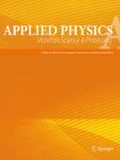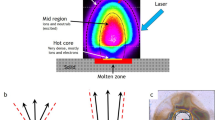2
matrix by ion-beam mixing of SiO2/Ag multilayers is studied via Rutherford backscattering spectrometry, optical absorption, and transmission electron microscopy experiments. In a first step, irradiation with MeV heavy ions transforms the continuous Ag layers into a string of micrometer-sized Ag inclusions. This mechanism can be attributed to lateral segregation of metallic atoms induced by irradiation. In a second step, the Ag inclusions are broken up by incoming ions and Ag nanoclusters are formed by agglomeration of mobile Ag atoms. The latter mechanism is likely due to a combination of ballistic mixing and radiation-induced segregation or radiation-enhanced diffusion processes. The size of the metallic nanoclusters formed depends also on the irradiation temperature.
Similar content being viewed by others
Author information
Authors and Affiliations
Additional information
Received: 27 October 1997/Accepted: 3 February 1998
Rights and permissions
About this article
Cite this article
Thomé, L., Rizza, G., Garrido, F. et al. Formation of metallic nanophases in silica by ion beam mixing. Part II: cluster formation . Appl Phys A 67, 241–247 (1998). https://doi.org/10.1007/s003390050765
Issue Date:
DOI: https://doi.org/10.1007/s003390050765




